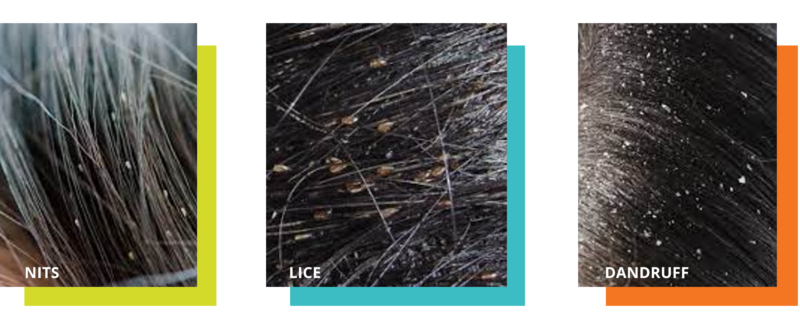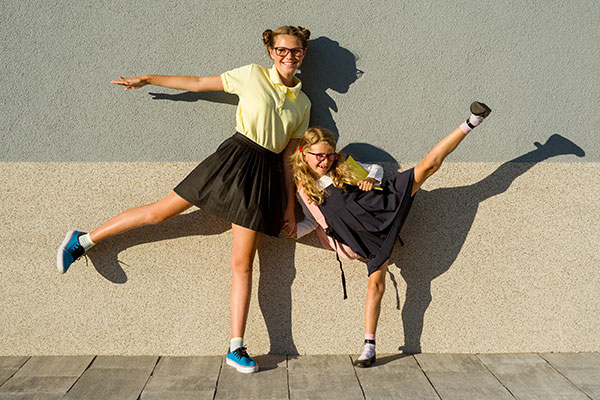
Everything You Always Wanted to Know About Head Lice
(But Were Afraid to Ask)
Lice develop in three stages: nit, nymph, and adult louse.
WE AGREE! LICE ARE … GROSS! It’s horrifying to find lice in your child’s hair!
Nits are oval-shaped lice eggs that are laid by an adult female near the base of the scalp.
- Nits are approximately 0.8 mm in size (similar to a sesame seed) and they resemble dandruff.
- Nits will emulate the color of their host’s hair.
- Females lay their eggs with glue, which makes them difficult to remove from the hair.
- Nits on hair shafts, hatch in 6-10 days.
- Each female louse will lay 5-8 eggs per day for 30 days.
Nymphs are…When a nit hatches, a nymph is born.
- Nymphs are just smaller versions of adult lice, with six legs that each have a claw attached to the tip.
- Growing nymphs must feed on human blood five to six times per day to survive.
- The nymph molts as they grow until they finally reach the adult phase of life.
Adult louse…A fully grown louse will reach 2.5-3 mm in length.
- Lice are actually quite transparent and will often emulate the color of their host’s hair.
- They do not have wings and are only able to transport themselves by crawling from hair strand to hair strand (or, from head to head)
- If a louse falls off of its host’s head it has 24-48 hours to find a new food source.
- The females will lay 5-8 eggs per day for 30 days.
According to the CDC, adult head lice are roughly 2–3 mm long – making them very difficult to see.
Head lice infest the head and neck and attach their eggs to the base of the hair shaft. Lice move by crawling; they cannot jump or fly.
Head lice are mainly spread by direct contact with the hair of an infested person.
The most common way to get head lice is by head-to-head contact with a person who already has head lice.
Such contact can be common among children during play at:
School
Home
Activities
(e.g., sports, dance, gymnastics, playgrounds, camp, and slumber parties to name a few).
It is quite common for parents to spend hours treating head lice without solving the problem. At Licenders we are experts in lice and our heated air technology gets rid of lice and their nits in one treatment. That’s our promise!
RELIABLE DATA FROM THE CDC
The CDC estimates that 6 to 12 million headlice infestations occur each year in the United States among children 3 to 11 years of age.
Some studies suggest that girls get head lice more often than boys, probably due to more frequent head-to-head contact and long, swingy hair.

Two lice viewed under an electron microscope. Note: Their claws are used to grasp onto individual hairs. (Photo Credit: CDC)
NITS VS DANDRUFF

INFORMATION FOR PARENTS
How Children Get Head Lice
Contrary to what you might suspect, lice are not attracted to dirty hair. In fact, nothing makes a louse happier than nice, clean hair.
Lice do not jump, hop, or fly – the only way they move is by crawling. They are transported on belongings such as combs, brushes, towels, beds, couches, pillows, carpet, stuffed animals, hats, coats, sports helmets, and clothing. Also, when they play together in very close surroundings, lice can often move from child to child. Even taking a selfie gives a louse a perfect opportunity to travel from head to head!

INFORMATION FOR SCHOOLS
We know how disruptive a head lice infestation at school can be.
School settings are the perfect environment for head lice to transfer from child to child.
How To Prevent A Lice Infestation At Your School
With early detection, you can reduce the chances that an infestation will occur at your school. Screenings should be performed at the start of the school year, and after major vacation breaks.

THE SYMPTOMS OF LICE INFESTATION
- Itching is usually the first sign that lice may be present. It is also the most common lice symptom.
- Sometimes small red sores will form on the scalp from vigorous scratching after being bitten by the louse.
- Your child has been exposed to a friend with lice.






